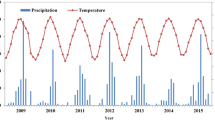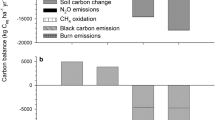Abstract
Short-rotation coppice willow (SRCW) is a fast-growing and potentially high-yielding energy crop. Transition to bioenergy has been identified in Sweden as one strategy to mitigate climate change and decrease the current dependency on fossil fuel. In this study, life cycle assessment was used to evaluate and compare the climate impacts of SRCW systems, for the purpose of evaluating key factors influencing the climate change mitigation potential of SRCW grown on agricultural land in Sweden. Seven different scenarios were defined and analysed to identify the factors with the most influence on the climate. A carbon balance model was used to model carbon fluxes between soil, biomass and atmosphere under Swedish growing conditions. The results indicated that SRCW can act as a temporary carbon sink and therefore has a mitigating effect on climate change. The most important factor in obtaining a high climate change-mitigating effect was shown to be high yield. Low yield gave the worst mitigating effect of the seven scenarios, but it was still better than the effect of the reference systems, district heating produced from coal or natural gas.




Similar content being viewed by others
References
UNFCCC (2011) Report of the Conference of the Parties on its sixteenth session, held in Cancun from 29 November to 10 December 2010. Part Two: Action taken by the Conference of the Parties at its sixteenth session. Decisions adopted by the Conference of the Parties. FCCC/CP/2010/7/Add.1
European Commission (2013) The EU climate and energy package. European Commission
Ericsson N, Porsö C, Ahlgren S, Nordberg Å, Sundberg C, Hansson P-A (2013) Time-dependent climate impact of a bioenergy system—methodology development and application to Swedish conditions. GCB Bioenergy 5(5):580–590. doi:10.1111/gcbb.12031
Heller MC, Keoleian GA, Volk TA (2003) Life cycle assessment of a willow bioenergy cropping system. Biomass Bioenergy 25(2):147–165. doi:10.1016/S0961-9534(02)00190-3
Statistics Sweden (2013) Land use in Sweden, 6th edn. Statistics Sweden, Regions and Environment Department, Örebro
Hollsten R, Arkelöv O, Ingelman G (2013) Handbok för salixodlare (Manual for willow farmers), Secondth edn. Jordbruksverket (Swedish Board of Agriculture), Jönköping
Djomo SN, Kasmioui OE, Ceulemans R (2011) Energy and greenhouse gas balance of bioenergy production from poplar and willow: a review. GCB Bioenergy 3(3):181–197. doi:10.1111/j.1757-1707.2010.01073.x
SOU (2007) Bioenergi från jordbruket – en växande resurs. Bilagedel (Bioenergy from agriculture—a growing resource. Appendix). Statens offentliga utredningar, Stockholm
Dimitriou I, Rosenqvist H, Berndes G (2011) Slow expansion and low yields of willow short rotation coppice in Sweden; implications for future strategies. Biomass Bioenergy 35(11):4613–4618. doi:10.1016/j.biombioe.2011.09.006
Quinkenstein A, Pape D, Freese D, Schneider BU, Hüttl RF (2012) Biomass, carbon and nitrogen distribution in living woody plant parts of Robinia pseudoacacia L. growing on reclamation sites in the mining region of Lower Lusatia (Northeast Germany). Int J For Res 2012:10
Cherubini F (2010) GHG balances of bioenergy systems—overview of key steps in the production chain and methodological concerns. Renew Energy 35(7):1565–1573. doi:10.1016/j.renene.2009.11.035
Börjesson P (2006) Livscykelanalys av Salixproduktion (Life Cycle Assessment of Willow Production, english abstract) (Life Cycle Assessment of Willow Production). Institutionen för teknik och samhälle. Avdelningen för miljö- och energisystem, Lund
González-García S, Mola-Yudego B, Murphy R (2013) Life cycle assessment of potential energy uses for short rotation willow biomass in Sweden. Int J Life Cycle Assess 18(4):783–795. doi:10.1007/s11367-012-0536-2
González-García S, Mola-Yudego B, Dimitriou I, Aronsson P, Murphy R (2012) Environmental assessment of energy production based on long term commercial willow plantations in Sweden. Sci Total Environ 421–422:210–219. doi:10.1016/j.scitotenv.2012.01.041
Fuglestvedt JS, Berntsen TK, Godal O, Sausen R, Shine KP, Skodvin T (2003) Metrics of climate change: assessing radiative forcing and emission indices. Clim Chang 58(3):267–331. doi:10.1023/A:1023905326842
Shine KP, Fuglestvedt JS, Hailemariam K, Stuber N (2005) Alternatives to the global warming potential for comparing climate impacts of emissions of greenhouse gases. Clim Chang 68(3):281–302. doi:10.1007/s10584-005-1146-9
Cherubini F, Guest G, Strømman AH (2012) Application of probability distributions to the modeling of biogenic CO2 fluxes in life cycle assessment. GCB Bioenergy 4(6):784–798. doi:10.1111/j.1757-1707.2011.01156.x
Sathre R, Gustavsson L (2012) Time-dependent radiative forcing effects of forest fertilization and biomass substitution. Biogeochemistry 109(1–3):203–218. doi:10.1007/s10533-011-9620-0
Zetterberg L, Chen D (2011) The time aspect of bioenergy—climate impacts of bioenergy due to differences in carbon uptake rates
Baumann H, Tillman A-M (2004) The hitch hiker’s guide to LCA: an orientation in life cycle assessment methodology and application. Studentlitteratur, Lund
Finnveden G, Hauschild MZ, Ekvall T, Guinée J, Heijungs R, Hellweg S, Koehler A, Pennington D, Suh S (2009) Recent developments in life cycle assessment. J Environ Manag 91(1):1–21. doi:10.1016/j.jenvman.2009.06.018
Andrén O, Kätterer T, Karlsson T (2004) ICBM regional model for estimations of dynamics of agricultural soil carbon pools. Nutr Cycl Agroecosyst 70(2):231–239. doi:10.1023/B:FRES.0000048471.59164.ff
Schlamadinger B, Apps M, Bohlin F, Gustavsson L, Jungmeier G, Marland G, Pingoud K, Savolainen I (1997) Towards a standard methodology for greenhouse gas balances of bioenergy systems in comparison with fossil energy systems. Biomass Bioenergy 13(6):359–375. doi:10.1016/S0961-9534(97)10032-0
Mola-Yudego B, Aronsson P (2008) Yield models for commercial willow biomass plantations in Sweden. Biomass Bioenergy 32(9):829–837. doi:10.1016/j.biombioe.2008.01.002
Guidi W, Pitre FE, Labrecque M (2013) Short-rotation coppice of willow for the production of biomass in Eastern Canada. In: Matovic MD (ed). doi:10.5772/51111
Rytter R-M (2001) Biomass production and allocation, including fine-root turnover, and annual N uptake in lysimeter-grown basket willows. For Ecol Manag 140(2–3):177–192. doi:10.1016/S0378-1127(00)00319-4
Brady NC, Weil RR (1999) The nature and properties of soils. Prentice Hall
Ahlgren S, Hansson P-A, Kimming M, Aronsson P, Lundkvist H (2009) Greenhouse gas emissions from cultivation of agricultural crops for biofuels and production of biogas from manure—implementation of the Directive of the European Parliament and of the Council on the promotion of the use of energy from renewable sources. Revised according to instructions for interpretation of the Directive from the European Commission 30 July 2009, Uppsala
IPCC (2006) 2006 IPCC guidelines for national greenhouse gas inventories, prepared by the National Greenhouse Gas Inventories Programme. IGES, Japan
Aronsson P, Rosenqvist H (2011) Gödslingsrekommendationer för Salix 2011 (Recommendations for willow fertilisation 2011)
Aronsson P, Rosenqvist H, Dimitriou I (2014) Impact of nitrogen fertilization to short-rotation willow coppice plantations grown in Sweden on yield and economy. BioEnergy Research:1-9. doi:10.1007/s12155-014-9435-7
Baky A, Forsberg M, Rosenqvist H, Jonsson N, Sundberg M (2009) Skördeteknik och logistik för bättre lönsamhet från små odlingar av Salix (Harvest and logistics for better profitability from small cultivations of Short Rotation Willow Coppice). Grödor från åker till energi. Institutet för jordbruks- och miljöteknik (JTI), Stockholm
Jonsson N, Jiris R (1997) Torrsubstansförluster och mikrobiell aktivitet vid lagring av salixflis (Dry matter losses and microbial activity during storage of willow chips). JTI
Paulrud S, Fridell E, Stripple H, Gustafsson T (2010) Uppdatering av klimatrelaterade emissionsfaktorer (Updated climate related emission factors). Swedish Meteorological and Hydrological Institute (SMHI), Norrköping
Uppenberg S, Almemark M, Brandel M, Lindfors L-G, Marcus H-O, Stripple H, Wachtmeister A, Zetterberg L (2001) MILJÖFAKTABOK FÖR BRÄNSLEN Del 2. Bakgrundsinformation och Teknisk bilaga (ENVIRONMENTAL FACT BOOK FOR FUELS. Part 2. Background Information and Technical Appendix). Andra versionen (second edition) edn., Stockholm
Aronsson H, Stenberg M, Rydberg T (2009) Kväve- och fosforutlakning från två växtföljder på lerjord med grön- och stubbträda (Nitrogen and phosphor leaching from two crop rotations on clay soil with green fallow and stubble, english abstract.). Ekohydrologi 113. Sveriges lantbruksuniversitet (SLU), Uppsala
Otabbong E, Persson J, Iakimenko O, Sadovnikova L (1997) The Ultuna long-term soil organic matter experiment. Plant Soil 195(1):17–23. doi:10.1023/A:1004276732679
Karlsson T (2012) Carbon and nitrogen dynamics in agricultural soils. Model applications at different scales in time and space. Doctoral Thesis, Swedish University of Agricultural Sciences, Uppsala
Kätterer T, Andrén O, Persson J (2004) The impact of altered management on long-term agricultural soil carbon stocks—a Swedish case study. Nutr Cycl Agroecosyst 70(2):179–188. doi:10.1023/B:FRES.0000048481.34439.71
Mulder K, Hagens NJ (2008) Energy return on investment: toward a consistent framework. AMBIO: J Hum Environ 37(2):74–79
Ramaswamy V, Boucher O, Haigh J, Hauglustaine D, Haywood J, Myhre G, Nakajima T, Shi GY, Solomon S (2001) Radiative forcing of climate change. In: Houghton JT, Ding Y, Griggs DJ et al (eds) Climate change 2001: the scientific basis. Contribution of Working Group I to the Third Assessment Report of the Intergovernmental Panel on Climate Change. Cambridge University Press, Cambridge, p 881
IPCC (2007) Contribution of Working Group I to the Fourth Assessment Report of the Intergovernmental Panel on Climate Change. Cambridge University Press, Cambridge
Joos F, Prentice IC, Sitch S, Meyer R, Hooss G, Plattner G-K, Gerber S, Hasselmann K (2001) Global warming feedbacks on terrestrial carbon uptake under the Intergovernmental Panel on Climate Change (IPCC) emission scenarios. Glob Biogeochem Cycles 15(4):891–907. doi:10.1029/2000GB001375
IPCC (2001) The scientific basis. Contribution of Working Group I to the Third Assessment Report of the Intergovernmental Panel on Climate Change. IPCC Third Assessment Report - Climate Change 2001 Cambridge University Press, Cambridge
Huijbregts MAJ (1998) Application of uncertainty and variability in LCA. Int J Life Cycle Assess 3(5):273–280. doi:10.1007/BF02979835
Röös E, Sundberg C, Hansson P-A (2010) Uncertainties in the carbon footprint of food products: a case study on table potatoes. Int J Life Cycle Assess 15(5):478–488. doi:10.1007/s11367-010-0171-8
Björklund AE (2002) Survey of approaches to improve reliability in LCA. Int J Life Cycle Assess 7(2):64–72. doi:10.1007/BF02978849
Dimitriou I, Mola-Yudego B, Aronsson P, Eriksson J (2012) Changes in organic carbon and trace elements in the soil of willow short-rotation coppice plantations. Bioenergy Res 5(3):563–572. doi:10.1007/s12155-012-9215-1
Rytter R-M (1999) Fine-root production and turnover in a willow plantation estimated by different calculation methods. Scand J For Res 14(6):526–537. doi:10.1080/02827589908540817
Dimitriou I, Mola-Yudego B, Aronsson P (2012) Impact of willow short rotation coppice on water quality. Bioenergy Res 5(3):537–545. doi:10.1007/s12155-012-9211-5
Acknowledgments
This research was funded by the STandUP for Energy program and Swedish Research Council Formas (project number 2009-2056).
Author information
Authors and Affiliations
Corresponding author
Rights and permissions
About this article
Cite this article
Hammar, T., Ericsson, N., Sundberg, C. et al. Climate Impact of Willow Grown for Bioenergy in Sweden. Bioenerg. Res. 7, 1529–1540 (2014). https://doi.org/10.1007/s12155-014-9490-0
Published:
Issue Date:
DOI: https://doi.org/10.1007/s12155-014-9490-0




